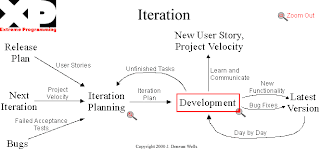Late last year, I participated in Cutter Consortium’s predictions for the year ahead. I’m getting ready to go out on a limb again and make another set of predictions for 2011. But in the meantime, I thought it would be good to reflect on the predictions I made for 2010:
-
XP 2.0. Agile engineering practices will gain traction as teams and organizations that have implemented Scrum work on increasing code quality. Practices like Test Driven Development, Automated Build and Test, and Continuous Integration will see wider acceptance. Several years after its initial surfacing, software craftsmanship (seehttps://manifesto.softwarecraftsmanship.org/) will gain in momentum.
-
Agile 2.0. Teams and organizations that have been practicing Scrum for 3 years or more will extend to hybrids like ScrumBan, Scrum/XP and even ScrumFall (if they lose executive sponsorship and are forced to backslide towards Waterfall). Kanban will continue to gain in momentum and mindshare.
-
Business 2.0. More small to medium-sized companies will initiate enterprise-wide transformations, using Agile development principles in concert with Lean business process improvement in an attempt to transform their businesses in today’s harsh economic climate.
-
Agile Failure 1.0. There will be more failures in agile adoption, as organizations attempt to drive the agile practices without fully understanding the agile principles; or simply jump onto the agile bandwagon and continue to practice waterfall (or whatever) while calling it agile.
I think I was
reasonably accurate with my Agile 2.0, Business 2.0 and Agile Failure 1.0 predictions. Kanban continues to gain significant momentum and many organizations are easily applying both methodologies. One interesting application is Kanban for service/help desk. See
Roland’s excellent blog post for an example of this. We have personally assisted with enterprise-wide transformations this year, interestingly with medium-sized companies. Finally, I saw a Forrester Research statistic recently that puts the percentage of “ad hoc” agile adoptions at a whopping 50%, meaning that half of the companies adopting agile (or at least the ones Forrester surveyed) are not approaching agile adoption in a structured and disciplined way.

Okay, last but not the least,
my XP 2.0 prediction fell way short, at least to my knowledge. Companies continue to struggle to adopt the high level of discipline that XP demands. While some of XP’s tool-assisted techniques like continuous integration and automated testing are gaining traction, I do not see too many teams with a complete set of practices (see diagram from Don Wells’ classic site:
https://www.extremeprogramming.org).
So, all in all, I suppose 3 out of 4 ain’t bad? As Neils Bohr said, “predictions are difficult to make, especially when they are about the future.”
Happy Thanksgiving to our friends in the U.S.A.

